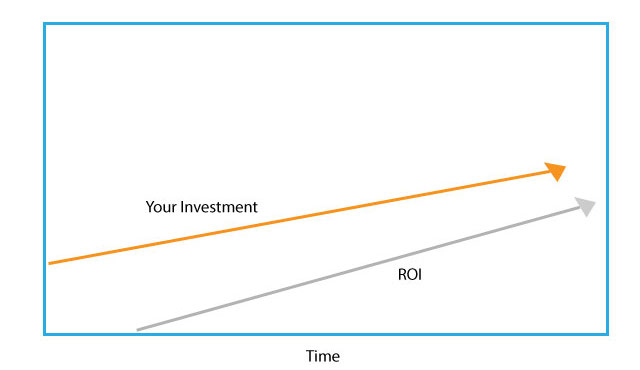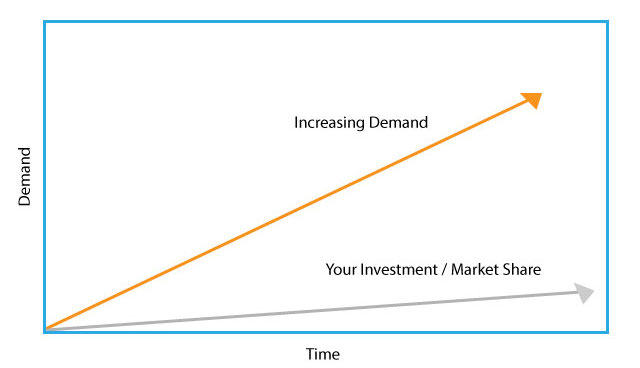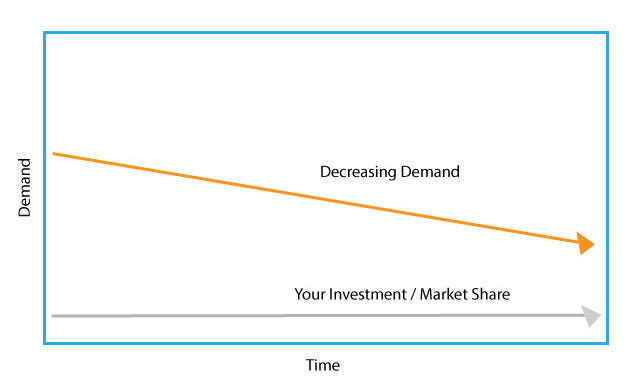
Updated: June 2023
The weather is heating up and the sound of ice cream trucks fill the air. Summer is here and everyone is thinking time off. If your boss is out of the office or your team is on hiatus, its a perfect time to do a deep dive into your website reporting. In this article you’ll learn the following concepts:
- What is ROI?
- What is a KPI?
- How long does it take to see results from digital marketing efforts?
- What is a good ROI for startups?
- What is a good ROI for established businesses?
- What to expect: High margin companies
- What to expect: Low margin companies
What is ROI?
ROI, or return on investment, is a great way to measure your marketing efforts across different channels and opportunities. I’ve found that it is much easier for an e-commerce website to calculate ROI than other industries such as B2B or lead generation. B2B lead sources can be more relationship based and could be a result of trade shows, partnerships, or non-profit affiliations that help brand awareness.
What is a KPI?
KPI or Key Performance Indicator, is a measurable value that helps companies assess their progress towards achieving business goals. An arbitrary goal like “more leads” typically isn’t a KPI. KPIs have historical context relative to website performance.
An arbitrary goal like “more leads” typically isn’t a KPI.
How long does it take to see results?
For lead generation or B2B, the final sale could take several months after the initial campaign start. Getting an accurate ROI number for sales that take many months can be challenging. For lead generation or B2B, simply applying an average closed sale value to your tracking reports may be enough. An average closed sale of 20% of total leads closed with a value applied may be enough to get you started. How long it takes can depend on your goals and budget. Have a low budget, expect it to take much longer to reach your goals.
Have a low budget? Expect it to take much longer to reach your goals.
Whether your company is new to ROI and KPI tracking or you have been tracking ROI for years, the question always becomes “What is a good ROI?” How do you know if 3 or 4 times your investment is a good ROI number? Should you expect high ROI for a website that launched a few months ago? Where does your product find itself in the “product life cycle“?
I have provided a few different scenarios that can help you determine what kind of ROI you should expect depending on your situation.
What is a good ROI for a startup company?
The New Kid in Town
Ok, so you’ve just launched a brand spankin’ new website with all the bells and whistles (toot toot, bing bing). Ok, what time does the money train get here? Hold up. You just launched a new site: new to search engines, new to customers, new to advertisers, etc. It’s going to take several months or even years before you can expect to see high ROI numbers. If you do a little better than break even with your marketing investment in the first several months, consider that a success. In general, the more you invest over time, the better your return will be but will not significantly change without further investment.

The Danger of Under Investing
Don’t make the mistake of under-investing in your marketing efforts, especially when you’re first starting out. Without enough spend in advertising or enough ongoing support for your website, you will likely generate only a handful of orders each week. Understand that even some of the best websites get a 2-5% conversion rate. That means you will need around 25-50 visitors for every sale you make.
Set your marketing budget inline with your target sales goals. Make sure you’re budgeting enough to drive enough visitors to make those sales. Give your campaigns some time to reach those goals, then adjust your budget over time.
What is a good ROI for an established business?
Keeping Customers Happy
You’ve had a website generating sales for several years and your ROI is in the 10+ times spend range. Hopefully, you’ve grown your customer base by providing good customer service. Over time, repeat customers will be your best friend. Growing your customer base should result in improved ROI over time. Maybe you should expect a much higher ROI from your organic search or advertising campaigns.
In A Growing Market
If you are seeing good ROI numbers (8-15x spend) from your campaigns, it may be time to increase your investment to gain market share. If you are in a growing industry, keeping the same budget and ROI each year will result in a net decrease in market share as your competitors step in to grab the extra customers. Make sure to keep your ROI in perspective.

If you find your product is in a growing market, the time to capture market share is now. Don’t settle for “good enough”.
In A Shrinking Market
If you are in a shrinking market with less and less demand for your products, you will need to increase your investment each year to avoid losing market share. Generally, there will be the same number (or more) competitors seeking a larger portion of that slowly shrinking market. It may be difficult to grow your share of the market with decreasing demand. Even if you are seeing good ROI numbers, you may still be losing customers as the total customer base decreases over time.

In the scenario above, it’s very difficult to improve your business without investing more into high ROI activities. Is it time to expand your product line? Should you double down on your advertising to keep pace? These are all consideration when trying to keep a business growing or just keep pace with competitors in your industry.
So what is a good ROI for marketing?
As you can see from the examples above, your ROI is only “good” relative to the market opportunity, your ongoing investment, and at what stage your business finds itself in. Getting a handle on what you get in return for your marketing spend is the first step, understanding what to do with those numbers is key. Margins are going to be a factor when evaluating your investment but don’t let that be the determining factor that holds you back from growth.
High Margin Company
If you are a company with high margin products, generally >30% margins, you may be able to simply ramp up spend to reach your goals. Assuming your ROI is consistently positive and predictive, you can forecast your ROI based on how much you expect to get back for every dollar spent. A return on ad spend (ROAS) is a common way to track this type of activity. Keep track of that ROAS and give yourself a range for error. Not every campaign scales at the same rate over the same time period. It might take you 6-12+ months to reach your goals. Having historical metrics from past years is important to get a realistic goal. If your company is making 2-3x your advertising spend, don’t expect to jump to 8x spend anytime soon.
- Established Brand: 3-8x ROAS
- New Brand (less than 2 years): 2-3x ROAS
New brands may have to ramp up spend to capture market share so they may need to target lower ROAS goal in order to achieve market share growth.
Low Margin Company
A company with generally lower margin products, generally <30% margins, will be forced to do much of the marketing activity internally, hire freelancers or lower skilled workers to do a bulk of the marketing. If your company falls into this profile, the best way to grow is likely organically. Start out with a simple product, easy to use website (or app), and clear branding to make it easy for customers to buy. The more marketing you need to sell your product, the harder it will be to see a profit. Lack of brand awareness or a difficult to understand product can make the job of marketing that much harder. Lower margins typically restrict the opportunity to increase ROI and grab market share. Focus on brand awareness through high visibility channels where there is less ad competition but greater opportunity to reach more customers (Google search, YouTube, Instagram, etc.).
- Established Brand: 3-5x ROAS
- New Brand (less than 2 years): 1-2x ROAS
Please Share
I hope you have enjoyed this post on ROI and e-commerce. If you found this information helpful, please share on Twitter, Linkedin, Mastodon, or Meta / Facebook.
Photo Credit: Karah Levely-Rinaldi via CC
